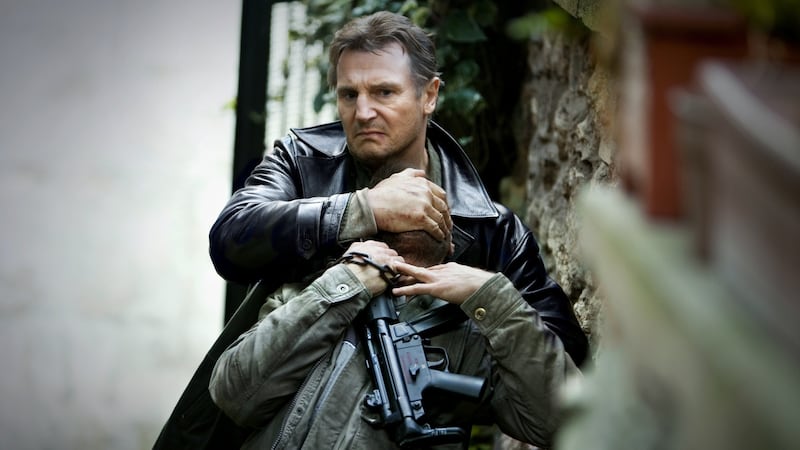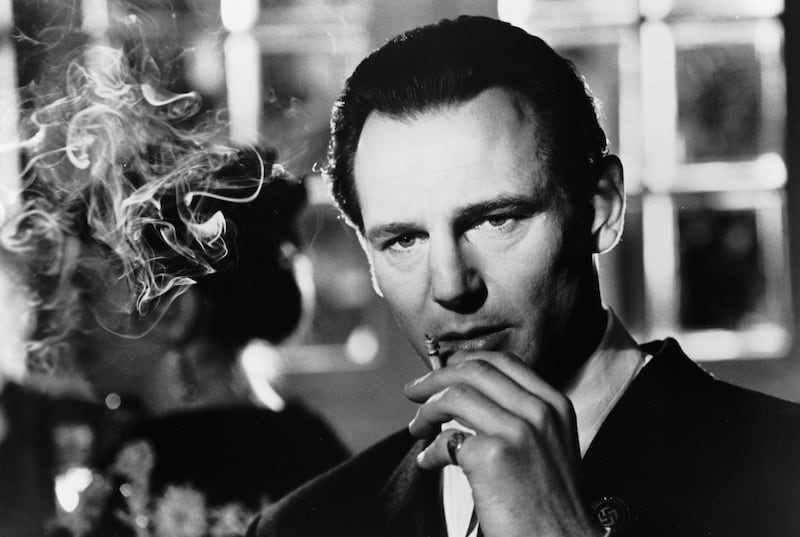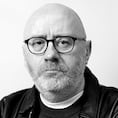Liam Neeson is taking over the lead role in the Naked Gun series from Leslie Nielsen. This makes some sense. If you watched his supporting turn in Ricky Gervais’s Extras or Lisa McGee’s Derry Girls, you will know he has a good line in deadpan comedy. The action roles he’s focused on over the past decade and a half provide him with a persona on which he can ironically riff. But he is in a very different place to Nielsen when he moved into comedy with Airplane! in 1980.
The Canadian performer was a busy, but only modestly famous, “that guy” actor of the chiselled school. It was the Zucker brothers’ Airplane! and, from the same team, Naked Gun that belatedly made him a star. He is the beloved straight-faced comic who bossed the stuffed-beaver joke.
Neeson comes to The Naked Gun – a “legacy sequel” to 1994’s Naked Gun 33⅓: The Final Insult – as an Oscar- and Tony-nominated actor who has worked with Steven Spielberg, Martin Scorsese, Neil Jordan, Christopher Nolan, Woody Allen and Clint Eastwood. He was an Irish movie star when we didn’t really have such things.
As a young man he acted at the Lyric Theatre in Belfast and at Project Arts Centre in Dublin. He has played God on TV and (as Aslan the lion) an incarnation of Jesus Christ on film. It’s rather as if, in 1980, the Zuckers had chosen Richard Burton as their comic lead.
READ MORE
Then again, the art to being Neeson has always involved some defiance of expectations. In early 2009 many raised eyes at him appearing in a straight-up action film. Taken proved an enormous hit – one of his defining roles – and he has spent much of his senior years leaping from helicopters and evading rocket-propelled grenades. Why wouldn’t he take on the role of Frank Drebin jnr, son to Nielsen’s elder Drebin, opposite the tireless Pamela Anderson in The Naked Gun?
“I thought, yeah, I guess I could do that as long as I play it dead seriously and not try and imitate Mr Leslie Nielsen. He was wonderful,” Neeson said before shooting began. “I’m looking forward to it. It’s a good script and there’s a few laugh-out-loud moments in it.” Now that’s how an Ulsterman boosts a screenplay. “A few laugh-out-loud moments.” Don’t get carried away, big man.
Then there is that other great Neeson anomaly. He is a reticent interviewee, often bordering on uncommunicative, who nonetheless has an extraordinary ability to put his huge foot in it (whatever “it” might be that week). He doesn’t blurt out often. But when he does, nobody blurts quite like him. Neeson is the Botticelli of blurt.
I have been bumping into Neeson for a long time. Looking back at our interviews, I was surprised to discover that, 23 years ago, he was already having to manage his propensity to manoeuvre boot into ordure. “He raises his hand, shakes his head and exhales a pained sigh,” I wrote. “Having put his foot in it once too often in the past, the 50-year-old actor is now inclined toward a great deal of head shaking and sighing.”
In 2002? This was long before his controversial blurt on the Weinstein affair, the misinterpreted blurt on becoming a Muslim and, most notoriously, that blurt on his brief inclination to become a vigilante. In 2022 he was still cleaning up after what now seems like a throwaway gag about quitting the business.
“Well, this lady didn’t get it,” he said. “I didn’t mean it. But before long, my agent was getting calls. And he was phoning me up: am I giving up the business? But it really was all my own fault.”

My memory is of a fellow minding every syllable he uttered. This straight-talking Ballymena man wasn’t made for the microscopic attention of the contemporary press tour. He found a place in Hollywood. He is long resident in New York. But Ulster still runs strong in his psyche.
The son of Barney, a school caretaker, and Kitty, a cook, Neeson first fell for drama at St Patrick’s College in Ballymena. Piecing together his opinions on growing up Catholic in a heavily Protestant locale, one runs up against some apparent contradictions. In 2000 he declined the offer to take freedom of that Antrim town after local unionists objected to – perfectly reasonable – comments he had made about how Catholics were treated there during his childhood. Maurice Mills, a DUP councillor, said Neeson had “vilified the people of this town and in particular the Protestant people”. (Neeson ended up accepting freedom of the town in 2013.)
In truth, the actor has never played the poor mouth when talking about his early years in Ballymena.
“I personally never really experienced huge sectarianism there,” he told me in 2018. “I have said before – and I got in trouble for saying it – that we were second-class citizens in the North. That being said, I was made head boy at a school that was predominantly Protestant.”
At any rate, the acting bug got hold of him early. An early influence was, bizarrely, his fellow Ballymena man Ian Paisley, whose Old Testament vehemence he used to savour surreptitiously from the back of that troublesome clergyman’s church.

Neeson’s parents were, understandably enough, concerned about him moving into acting – he had briefly studied physics and computer science at Queen’s University – but were surely pacified when, in 1975, he successfully auditioned for the Lyric Theatre in Belfast. Speaking to him at a public interview in 2009, I was moved by how fondly he remembered his own excitement at acing the audition. He could still walk me through the journey from Belfast back to Ballymena.
“I opened and closed that bit of paper so often it was almost worn through,” he said. “I showed it to every soldier I met. But those were violent times. I got back at 11.30pm and my parents were expecting me home at 5.30pm.”
He pointed back to the white cinema screen behind us.
“By the time I got back their faces were that colour. God, they were furious.”
The succeeding decade looks a little like a happy slog. There were few enormous breaks. He worked steadily in increasingly respectable roles. After the Lyric, Neeson had a spell at Project and another at the Abbey, both in Dublin, before John Boorman talent-spotted him for a role in the 1980 film Excalibur. He there met Helen Mirren, and they spent five years as a couple in London. Heady times. She was moving into her pomp while he was still making the steady ascent.
“We loved each other. We were not meant to be together in that way, but we loved each other very, very much,” Mirren said, years later. “I love him deeply to this day. He’s such an amazing guy.”
[ Liam Neeson: Unexpectedly beating up people at age 65Opens in new window ]
Neeson eventually took a deep breath and lunged for Hollywood. He got a decent job in The Bounty, opposite Anthony Hopkins. You can catch him in the Palme d’Or-winning The Mission. He started his auteur run with the Dead Pool, for Clint Eastwood, in 1988 and Husband and Wives, for Woody Allen, in 1992. By that stage he was in a position where work seemed secure. Maybe he would never be a star of the brightest magnitude – time was clattering on – but there are worse things than life as a middle-aged character actor.
[ How did that nice Liam Neeson become a psychopathic killing machine?Opens in new window ]
Schindler’s List, from 1993, secured his place in the firmament. It is said that, after many auditions for the role, Spielberg’s mother-in-law eventually identified him as the only man for the job.
“I’ve been told everyone was chasing that role,” Neeson told me. “I know that Kevin Costner, who was a huge star, wanted the part, and he would have been very good. I believe Robert Duvall was mentioned at one stage.”
Duvall, maybe. But Costner? Such speculation is now pointless. There’s a stoic gentleness to Neeson that was perfectly suited to the role of a playboy businessman who, against his everyday nature, finds himself softening to the plight of German Jews as the Holocaust gathers pace. He has the gangly integrity of Gary Cooper but with none of that actor’s ingenuous, aw-shucks naivety. Early years as a boxer and a brewery worker hardened his frame. Neeson knows how to be a serious man.
He was nominated for best actor at the Oscars (his only nod to date) but lost out to Tom Hanks for Philadelphia. Schindler’s List was probably the shortest favourite to win best picture in the awards’ history. Neeson had made an interesting journey. Still in his early 40s, he arrived to stardom as a premature veteran. He could be very funny, but there was nothing playful or trivial about his persona. When a Neeson character entered the room those already there tended to mind their manners.
Three years after Schindler’s List he headlined a film that, for about a year, registered as the highest-grossing title ever in Ireland. It is hard now to appreciate the furore that attended the release of Neil Jordan’s Michael Collins, in 1996. The Celtic Tiger was just starting to bite. The divorce referendum had snuck through. Now Warner Bros had arrived to deliver our own version of Lawrence of Arabia. The film won the Golden Lion at Venice, where Neeson picked up the Volpi Cup for best actor.

Neeson is from a long way north of Cork (well, what counts as a long way in Ireland). He was already a decade older than Collins was at the time of his death. But Jordan stuck with his old pal and, whatever disputes there were about the film’s political leanings, few questioned the worth of that lead performance.
“It was kind of terrifying, because it was a film I wanted to make, but to me it was just a film,” Jordan later said. “I’d known Liam since he was in the Project Arts Centre in Dublin, and when I was writing the script initially I spoke to him about it, and I said if I ever get to do this I’d like to do it with you.”
Schindler’s List surely helped that dream come true. In 2022 Neeson was asked why Michael Collins took so long to happen.
“Well, I think because of the war in Ireland,” he said. “And I think obviously because of the controversy over the subject matter. And also, who the hell’s Neil Jordan, and who the hell’s Liam Neeson that he wants to play Michael Collins? That business aspect of it.”
This is where it all came together for Neeson. He married Natasha Richardson, daughter of Vanessa Redgrave, in 1994, and they went on to have two children. Now the auteurs came to him. George Lucas cast him as Qui-Gon Jinn, wise mentor to a young Obi-Wan Kenobi, in Star Wars: Episode I – The Phantom Menace. The film has a terrible reputation, but it ultimately became the first Star Wars flick to take more than $1 billion. In acknowledgment of his status as a walking legend, Queen Elizabeth passed an OBE his way in 2000.
The past 15 years have, however, been turbulent. On the upside, in 2009, he made that surprising move towards action cinema and, then in his late 50s, established himself in the most taxing of genres as contemporaries were winding down into grandad roles. At Dublin Film Festival in that year, I asked when he knew he had properly made it.
“Well, it’s funny. Probably just the other week when Taken opened,” he said. “The film was released last year in Europe, and you’ve been able to download it for weeks from Korea or wherever, but it still became the biggest film at the box office in the US.”

Just a few weeks after our conversation, Natasha Richardson died in a freak skiing incident and Neeson’s priorities shifted accordingly. The support of Vanessa Redgrave and Joely Richardson, Natasha’s sister, proved invaluable.
“Everybody just pulled together,” Neeson said last year. “Vanessa and Joely were extraordinary. We were fortunate in lots of ways.”
“It is, you know, completely heartbreaking,” Joely told me. “I feel like we have been levelled in life and that we keep going for all the people we love.”
Neeson has, indeed, persevered. Barely a year goes by without him craggily rescuing hostages from a speeding train or hang-gliding into a narco-den. His most recent roles were Mike McCann in Ice Road: Vengeance and (no joke) Thug in Absolution. If you can pull that off at 73, then why not?
His biggest challenge may, however, be getting through the press tour for The Naked Gun without another incidence of blurting. His history here is extraordinary. We have mentioned his non-retirement in 2002. Ten years later it was reported he was thinking of becoming a Muslim.
“Ah, now, that was taken out of context,” he told me. “I remember doing a picture in Istanbul. The five calls to prayer initially drove me crazy. But after a few weeks I absolutely loved it. I bought a CD so that I could play it when I got back to New York. So then I was becoming a Muslim...”
In 2018, on The Late Late Show, he said that the fallout from the Harvey Weinstein scandal had caused “a bit of a witch-hunt” and noted that he was “on the fence” about allegations concerning Dustin Hoffman.
All of these disturbances were nothing as to the flak that landed when, a year after the Late Late incident, in a routine promotional interview, he told how, after a friend was raped by a black man, he went out “with a cosh, hoping I’d be approached by somebody”.
It got worse.
“I’m ashamed to say that, and I did it for maybe a week – hoping some [air quote gesture] ‘black b**tard’ would come out of a pub and have a go at me about something, you know? So that I could kill him,” he continued.
After the story broke Neeson went on Good Morning America and offered a convincing, self-lacerating gloss on the situation. The world moved on. Most got that he had simply chosen the oddest imaginable place to make a confession about a regretted incident.
No subsequent blurt has attracted such attention. But his PR handlers will be chewing their nails in the lead-up to the unveiling of The Naked Gun. Neeson is an absolute original. Almost entirely in good ways.
The Naked Gun is in cinemas from Friday, August 1st





















